Books about Macedonian
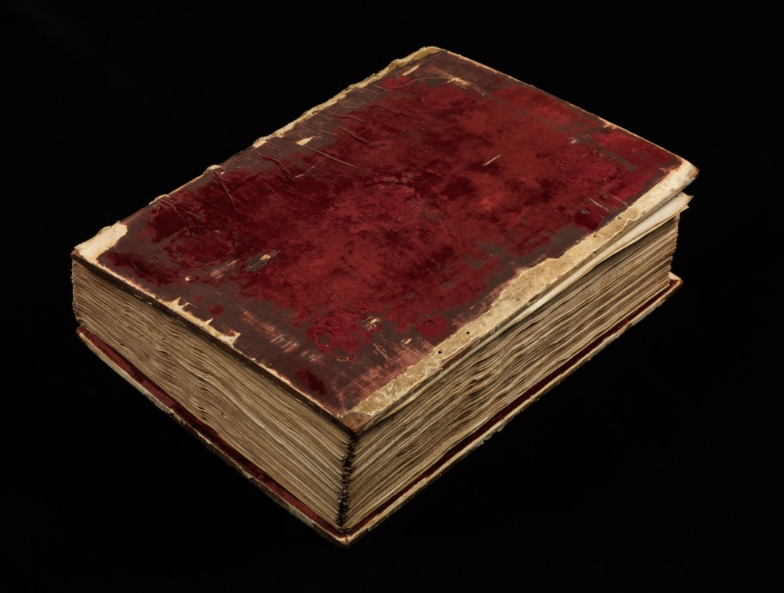
Another tome containing a narrative about the life of Alexander the Great: Quintus Curtius Rufus. "The Facts and Deeds of Alexander", Fr. 76 – f. 235 W. Geneva Library
but study in it day and night,
in order to do everything exactly,
what it says:
then you will be successful in your ways
and you will act wisely.
Joshua 1:8
Documents stories. Today we continue to consider historical books dedicated to Alexander the Great from the point of view of their significance, not so much as sources telling about Alexander himself, but as objects of study... of medieval culture and art.
The most valuable thing in science is the comparability and comparability of the results of identical studies. And it is precisely the stories about the life of Alexander the Great that provide us with a happy opportunity to look into the world of the past literally year by year, focusing on the release dates of certain books and... illustrations in these books.
And in fact, all the main facts from his life and its events are quite well known to us. But each time, medieval miniaturists depicted them differently, painted different costumes characteristic of their era, and even the proportions and manner of depicting the figures in their miniatures differed. And these differences seem extremely valuable, since they allow us to compare them and, based on these comparisons, draw conclusions about the changes that took place in the Middle Ages.
As a matter of fact, a lot of interesting things can be gleaned from almost any medieval manuscript containing illustrations.
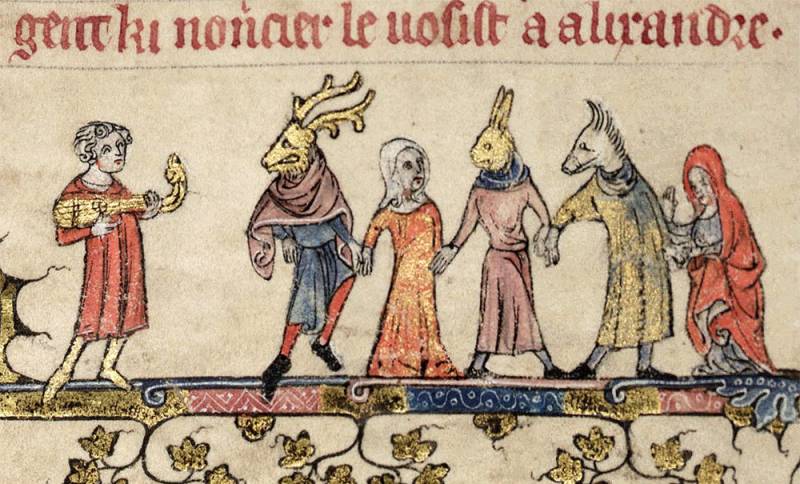
Here, for example, is a miniature from a manuscript from the Bodleian Library (The Romance of Alexander; Bodleiana Ms. 264, fol. 21v). It seemed like what was interesting here? But here’s the thing: the church was very disapproving of masked entertainment, considering them relics of paganism. And yet they were depicted even on the pages of books!
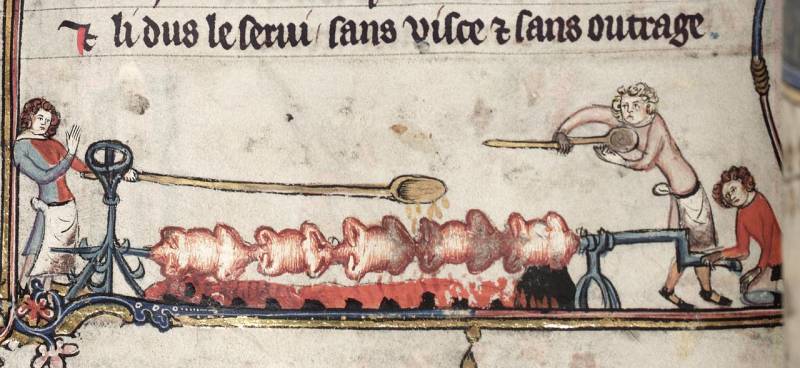
This same manuscript and what an interesting miniature! Poultry carcasses are roasted on a long spit, and the cook, covering his face from the heat, pours oil or sauce over them using a very long spoon. A small everyday scene, and nothing more. But it tells us a lot. People in the Middle Ages, as today, strived for maximum comfort, tried to make their lives easier in every possible way and came up with very original devices for this!
But let’s finish with everyday life for now and move directly to the miniatures from the stories about the life of Alexander the Great and, in particular, to the translation of the book “Facts and Deeds of Alexander” by Quintus Curtius Rufus, located in the Geneva library.
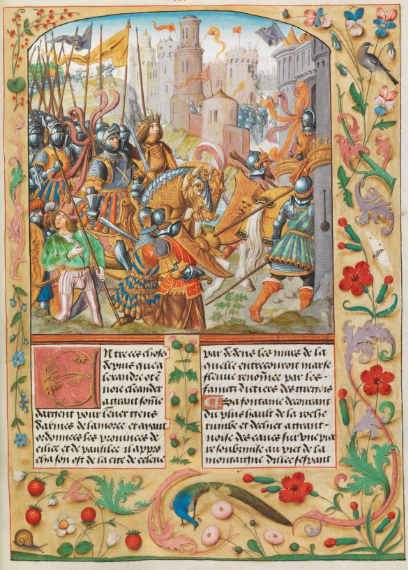
A very informative illustration from a Geneva book: Alexander is in gilded knightly armor, and there is nothing unusual about this. But still, the artist wanted to somehow hint that “back then, not everything was like it is now,” and he painted absolutely fantastic shields for Alexander’s soldiers. And he also depicted quite authentic highways with a valve in front of the figure of the warrior on the left. It was precisely these “pants”, sewn from fabric of different colors, that came into fashion at that time! That is, this book appeared after 1500
We have already drawn attention to the fact that a lot of books were written about him in the Middle Ages. One of the earliest translations from Greek was carried out by Julius Valerius in the XNUMXth century AD. e. Also early is the Latin version of Archbishop Leon of Naples, dating back to the XNUMXth century AD. e. - “The story of the battles of Alexander the Great.” Whereas in the XNUMXth century, Walter of Chatignon wrote his “Alexandride,” which was followed by translations by Lambert of Tours and Alexandre Bernet. It is clear that these were fairy tales in which truth was mixed with fiction.
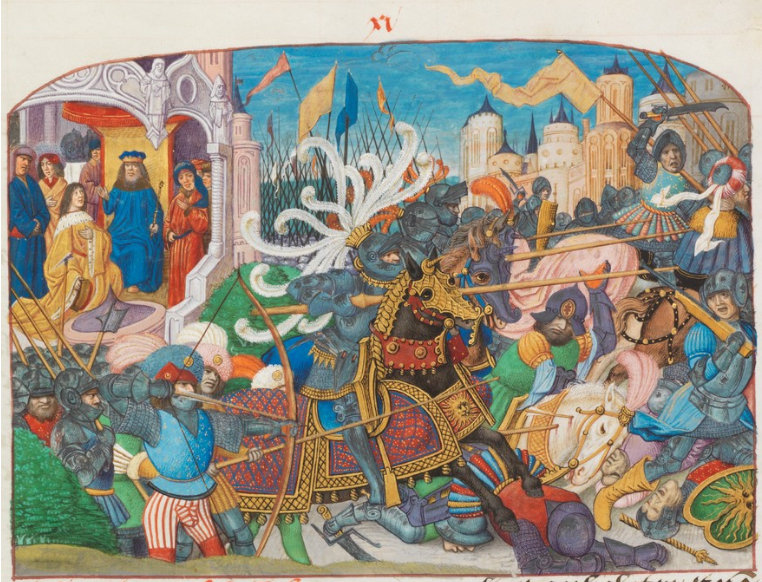
Another absolutely fantastic image of horse armor and... fashionable shoss on the archer on the left. And on the right you can see a warrior with a gun on his shoulder, that is, at this time similar examples of firearms weapons already existed!
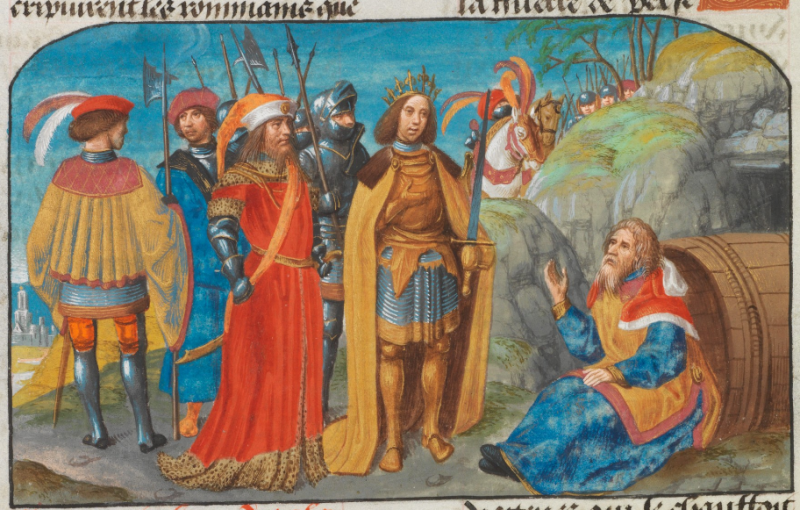
And this is a well-known scene: the meeting of Alexander the Great and Diogenes of Sinope in Corinth - one of the most popular jokes in the history of philosophy
But since people at that time themselves lived in a somewhat fairy-tale world, for many centuries they enjoyed great success. Moreover, they wrote about the famous commander not only in the West, but also in the East, which led to the appearance of many variation novels - “Alexandria”, which until the XNUMXth century were extremely attractive reading.
Moreover, the same “Roman of Alexander” was translated from Greek into Persian, Arabic, Armenian, Coptic, Malay and a number of other languages. Ferdowsi (“Shahname”), Nizami (“Iskander-name”), Alisher Navoi (“Iskander’s Wall”) and many other poets of the medieval East wrote about Alexander.
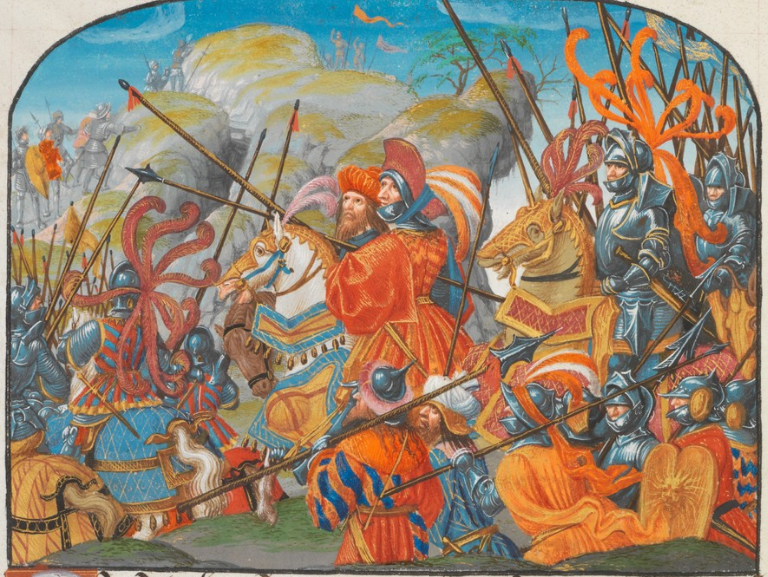
Despite the fantastic nature of this illustration, the Burgundian helmet-hat with a chin on the head of the warrior in the foreground is an excellent illustration of the existence of exactly this type of armor at the time of writing this book
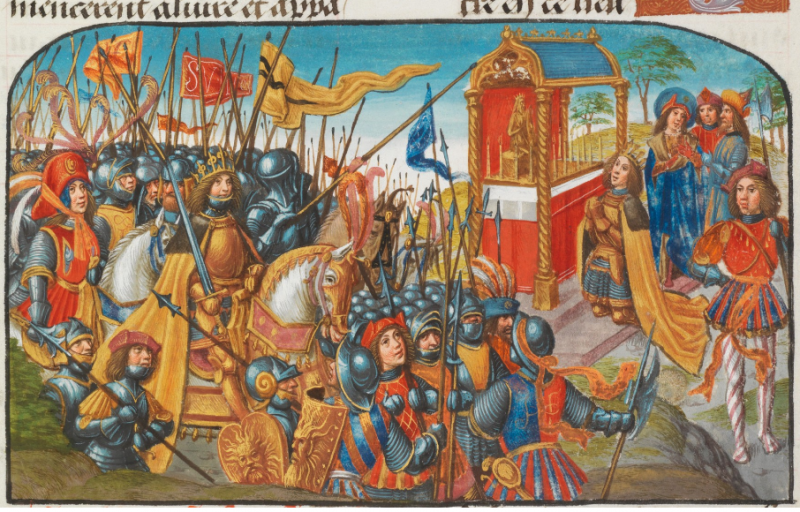
Well, here the absolutely fantastic shields are complemented by the image of the “toad’s head” tournament helmet on the knight to the left of Alexander. And that’s why the artist painted it, knowing for sure that this is part of the tournament, but not the combat vestment of the knight
Accordingly, French translations became the basis for the Alexander romances in England and Scotland, where the Romance of Alexander appeared in 1438. The novel was written in German and in verse by L. Lamprecht (around 1130), then in the XNUMXth century the Persians of Ulrich von Eschenbach and Rudolf of Ems appeared.
As a result, by the 90th century there were about 24 adaptations of “The Romance of Alexander,” published in XNUMX languages, and medieval manuscripts in Russian were known (as many as five editions from the XNUMXth to the XNUMXth centuries alone) and the Serbian “Alexandria” of the XNUMXth century. And if we consider that most of these manuscripts were equipped with illustrations, then what an amazing scope this opens up for visualizing the medieval era in its most varied variations and manifestations.
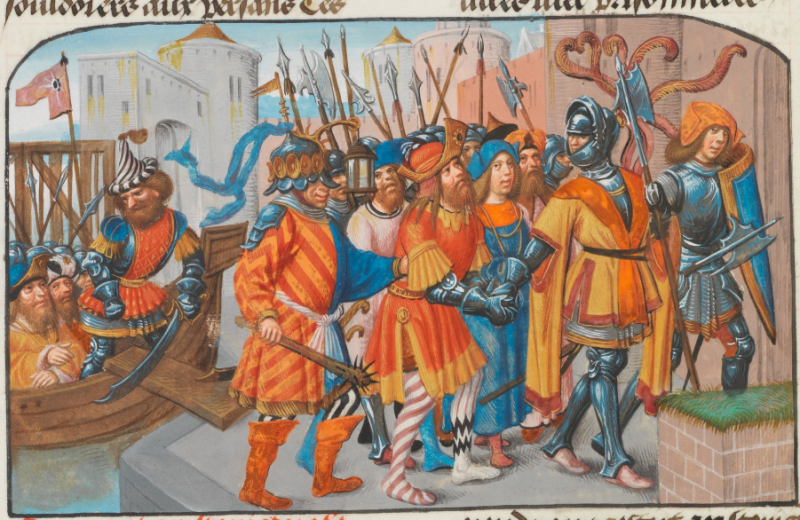
Who said that in the Middle Ages people wore everything dark, and only the nobility dressed up in bright colors? People at all times loved to dress in everything bright, and even more so when going to war. The artist very accurately depicted the halberds of that time, and even the common people’s spiked club studded with nails
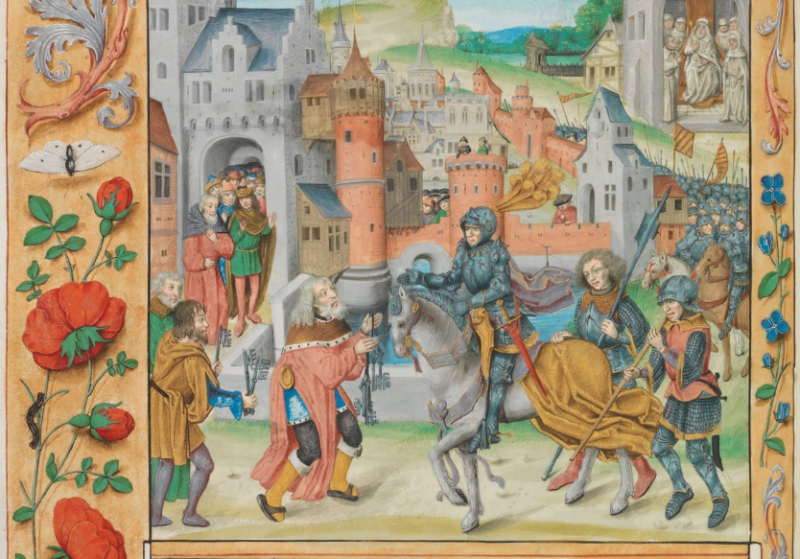
The rider is clearly wearing a brigantine under the lower part of the cuirass...
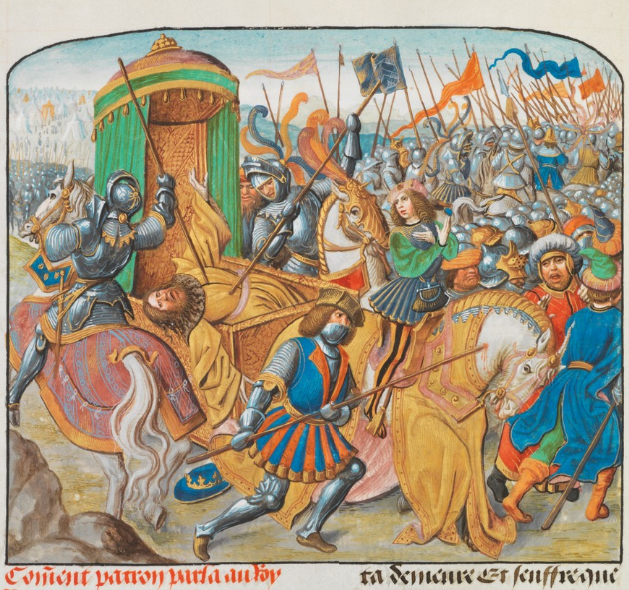
Death of King Darius. But what a cute wallet the artist drew on his page’s belt...
As we have already noted, the most popular “edition” was the book of the Roman historian Quintus Curtius Rufus - “The History of Alexander the Great”. One of Pliny the Younger’s letters says about him that he was born under Emperor Augustus, began his career under Tiberius, managed to stay alive under Caligula, and even became consul under Claudius in 45. He was awarded a triumph, commanded the Roman troops in Upper Germany, and finally, under Emperor Nero, received Africa as governorship.
All this, however, did not hinder his work as a historian. Moreover, he wrote Alexander’s biography in 10 voluminous volumes, of which volumes III–X have reached us. As for the translations of his book, researchers note that they all have the same omissions, and the first two volumes are missing from the translations.
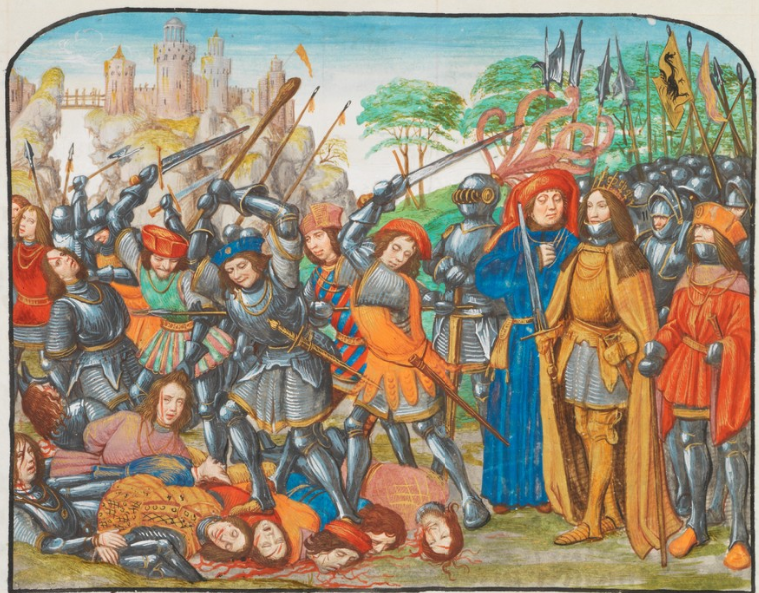
But on this cruel scene the skill of the artist of the new time is clearly visible. Faces are now depicted completely differently, although not for all characters yet. For example, a warrior in a red hat and green jacket even bit his lips from diligence...
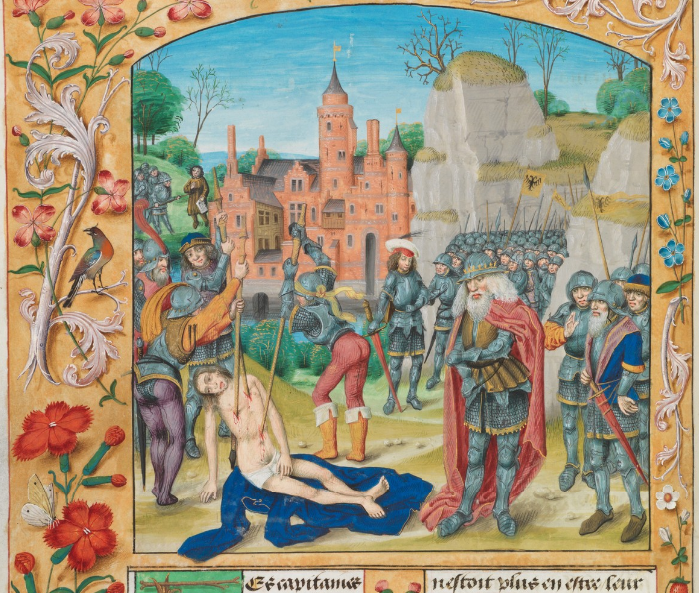
On the other hand, the illustrator never succeeded in violating the perspective in this drawing!
The first printed edition of Rufus's book was published quite early - already in 1470 in Venice. A surge of interest in the life of Alexander and, accordingly, books about him occurred during the Renaissance. But they also read them later. For example, there is evidence that Cardinal Richelieu read a book about Alexander during the siege of La Rochelle, and that it was his favorite book.
True, from the point of view of visualizing the past, this particular book is not very interesting for us, since the miniatures in it are quite primitive. However, Cardinal Richelieu was most likely not interested in them, but in its content itself.
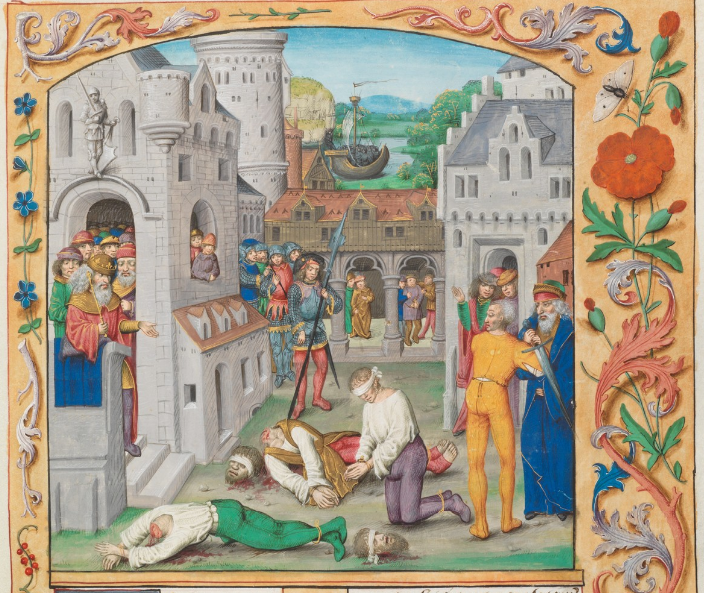
The most interesting thing in this miniature is... the pants of the executioner and the people he executed. They are sewn together with the foot! In fact, these are modern tights that also serve as shoes. But then why do we see pants with cut off socks here? The straight vertical seam on the pants is located at the back, and there is one on each side, which indicates the high skill of the cutter. Interestingly, the executioner's jacket is attached to the side of the pants with buttons
Let's pay attention once again to the publication date of the printed edition - 1470. That is, it was the time of Gothic armor with flutes and long pointed shoe toes. In any case, this is what the armor from Landshut (Southern Germany), made around 1480, looks like.
Many knights, as we saw in the illustrations of the previous material, wear a reinforced brigandine, covered with fabric, and ... the lower part of a double cuirass with a characteristic v-shaped vertical protrusion on the chest. However, already in 1500 the toe of knight's shoes became completely different. Now it looks like a “duck beak” and a “bear paw” and does not narrow at the end, but rather expands.
The “foot” of the knight’s sabatons’ shoes reaches its maximum width by 1550, after which it narrows somewhat again. That is, books written in the period from 1500 to 1550 should depict warriors in bear-paw shoes and, thus, even if the year of their publication is unknown, then, based on the illustrations, we can fairly accurately determine the time of their writing. After all, as we already know, the illustrators of that time did not have historical thinking and drew what they saw.
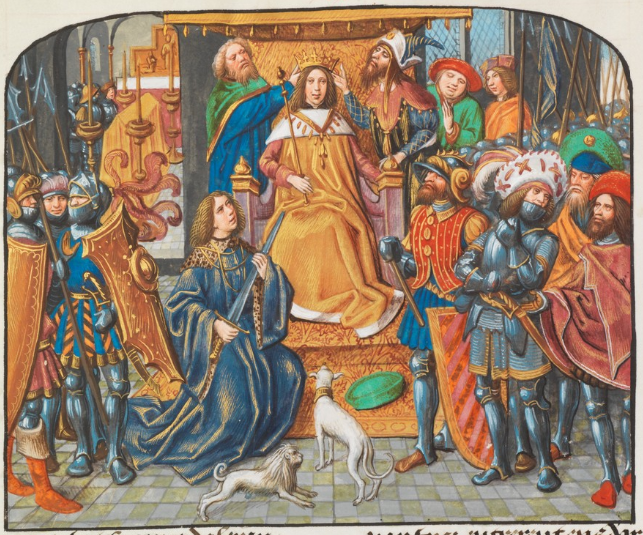
Coronation of Alexander. A motley mixture of illustrator's imagination with quite realistic images of plate shoes and armor
But did they give free rein to their imagination, and if “yes,” then in what exactly was it expressed? Is it really only in the peculiar depiction of elephants?
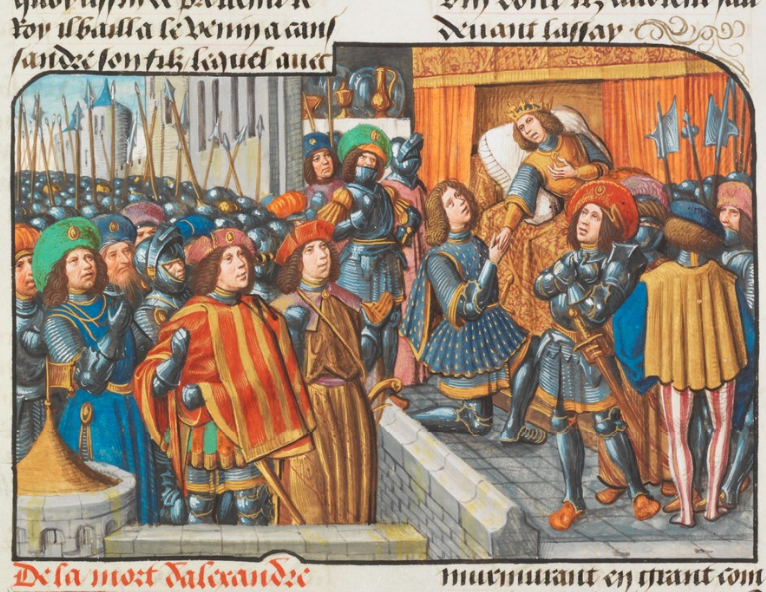
Death of Alexander. There is actually one complete realism here, except perhaps for the dying Alexander dressed in armor, and... simply wonderfully drawn striped highways - “pants” on the character on the right
And to answer this question and others, again related to illustrations from medieval books, we will be helped by turning to the “pictures” from the “History of Alexander...”, stored in the library of the city of Geneva.
And, of course, they are simply very beautiful, and they are simply pleasant to look at. And by looking at them, we can learn a lot of new and interesting things about the Middle Ages!
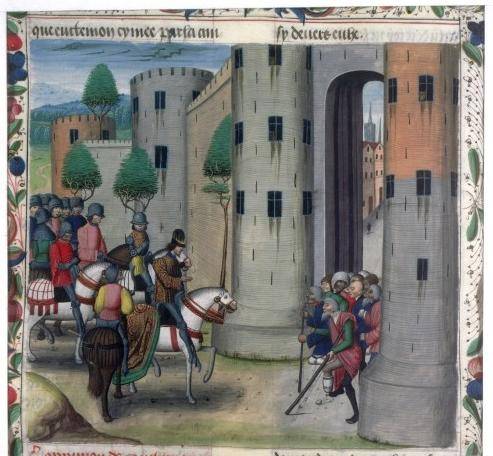
"Alexander enters Persepolis." Illustration from the French edition of “The History of Alexander...”, which was used by Cardinal Richelieu and which is kept in the library named after him. They don't cause much interest. Yes, they exist, but they are not at all colorful and poorly detailed. (Français 48, fol. 49v)
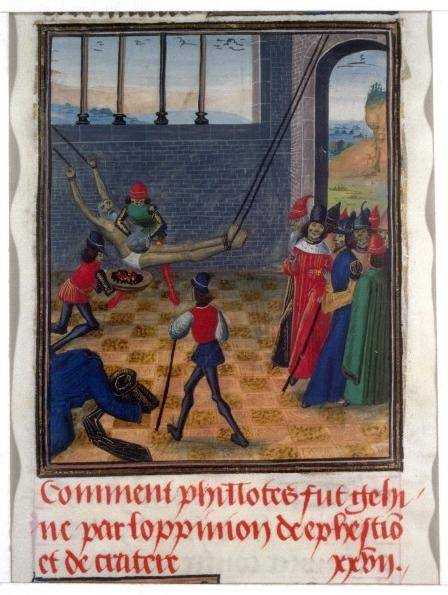
This illustration from another French publication (Français 48, fol. 86) shows the interrogation of Philotas, one of the commanders of Alexander the Great, convicted of treason. Yes, it’s hard to deny imagination to the executioners of the past, but, again, compared to the Geneva manuscript, its design is much inferior...
Information